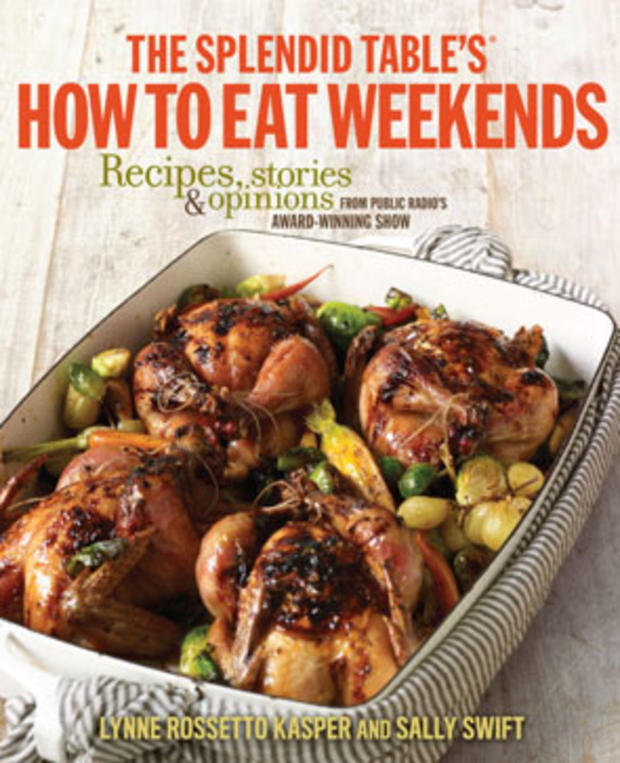Wander Minnesota: How To Eat Weekends
It's that time of year -- time to think about gifts for your nearest and dearest. Starting tomorrow on my other blog, I'm going to start "book week" -- a week devoted to books written by Minnesota authors and/or published by Minnesota publishers that would make great gifts. Of course, I'd be remiss if I didn't recommend my own book:
Available at many of the fine bookstores around the Cities.
Also available at fine bookstores everywhere is this book:
"How to Eat Weekends" by Lynne Rossetto Kasper and Sally Swift, of American Public Radio's highly regarded "The Splendid Table" radio program. This is a follow-up to the duo's earlier book, "How to Eat Supper", which handily disproved the theory that it's impossible to cook a decent meal after a busy day of work.
"How to Eat Weekends" is a companion book that says, "Now, when you do have time to spare, here's what you can do to really raise the stakes."
More than that, it brushes aside the notion that you have to be an advanced chef to make gorgeous and delicious meals for yourself and for guests. Kasper and Swift take readers by the hand and walk them carefully through each step, right down to how to find some of the less common ingredients at specialty markets.
Kasper recently spoke with me about the book and why it's valuable for today's cooks and eaters.
"It's a book for the time of the week when you have more time," she says. "We're at a time when people are cooking at home more now, but maybe people are missing the point—there's pleasure to be had here. The cooking is as pleasurable as the eating."
Not that the weekend cooking has to be difficult. Some of the recipes require more time than effort, while others are more hands-on.
"Cooking can engage you on so many levels," says Kasper. "You could really call this a therapy book. You can lose yourself in it."
It's also a great tool for newer cooks who would like host friends and family, but are uncertain how to put together a menu. Kasper and Swift put together several wide-ranging menus, from a Mexican comida to an Italian Renaissance supper to a Chinese celebration to a vegan Thanksgiving. More experienced cooks can peruse the dozens of additional recipes to create their own meal. All will benefit from the wine pairing suggestions.
"The Mexican meal is perfect for someone who's never cooked before," Kasper says. "It's so simple it's ridiculous. There's nothing you have to do -- it cooks itself."
She also notes that the growth of the Twin Cities' ethnic food sources has made life a lot easier for cooks who want to expand their range.
"We're lucky to be part of a community where the accoutrements are all here," she says.
And for the person who doesn't necessarily like to cook, but likes to read about food, this book is packed with vignettes and stories that are much like having—well, a good dinner with good friends.
To listen to the Splendid Table, find your closest radio station here.
Cider-Glazed Chicken
reprinted by permission, copyright Minnesota Public Radio
Serves 4; to double, use 2 pans
30 minutes prep time; 2 hours rest time; 1 hour stove time
This holds well 3 days in the refrigerator
Cook to Cook: A 12-inch straight-sided sauté pan is essential to this recipe's success because the chicken pieces must be spread out to glaze the way you want them. Use two smaller pans if necessary. To ensure a good glaze, don't cover the chicken at any point while cooking, and keep basting it with the pan juices.
3- to 3 ½-pound chicken (organic if possible), cut into 8 pieces, wing tips cut off
15 large fresh sage leaves
1 teaspoon kosher salt
½ teaspoon freshly ground black pepper
2/3 cup apple cider
1 cup cider vinegar
2 tablespoons good-tasting extra-virgin olive oil
1/3 cup minced onion
3 large garlic cloves, minced
½ large Granny Smith apple, peeled, cored, and cut into 1 ½-inch-long thin sticks
Garnish
Good-tasting extra-virgin olive oil
20 large fresh sage leaves
Salt
1. If possible, about 2 hours before cooking, rub the chicken with the sage leaves. Sprinkle all sides of the chicken with the salt and pepper and pile it all on a platter, tucking in the sage leaves here and there. Cover and refrigerate. When you're ready to cook, remove the sage leaves, but keep them handy. Pat the chicken dry. In a small bowl combine the cider and cider vinegar and set aside.
2. In a 12-inch straight-sided sauté pan (not nonstick), heat the oil over medium-high heat. Place the chicken in the pan, skin side down, so the pieces don't touch. Reduce the heat to medium or medium-low and cook the chicken for about 10 minutes, or until it is a rich golden brown on one side. To keep the chicken from sticking during browning, slip a metal spatula under each piece to loosen.
3. Turn the chicken pieces and brown the other side. Move the breast pieces to the pan's edge to slow their cooking. Remove the pan from the heat and spoon off all but 1 tablespoon fat.
4. These final steps should take about 25 minutes. Set the pan over medium heat, sprinkle the chicken with the onion, and add one third of the cider mixture to the pan. Cook slowly, uncovered, scraping up the brown glaze, and turning the chicken pieces occasionally. The idea is to keep coating the chicken with the pan juices until all of the liquid has cooked away. Keep the cider mixture simmering gently, taking care not to scorch it.
5. Repeat, slowly reducing and coating the chicken with another third of the cider mixture. Finally, add the remaining cider mixture along with the reserved sage leaves and the garlic. Spoon the pan juices over the chicken and scrape up the sticky glaze, turning the pieces to keep them moistened. Blend in ½ cup water and the apple and cook down the liquid about halfway.
6. The chicken is cooked when an instant-read thermometer inserted in the breast reads 165˚F. The sauce should be syrupy and rich tasting. If not, lift out the chicken to a platter to keep warm and cook down the sauce. Scrape the sauce over the chicken and let it rest for 10 minutes.
7. Meanwhile, wipe out the pan, coat it with a thin film of oil, and set it over medium-high heat. Fry the 20 sage leaves for 3 minutes, or until crisp. Salt the leaves, lift them out with a slotted spoon, and scatter them over the chicken. Serve hot.
What else is happening in our state? Be sure to check out the 10 p.m. Sunday night WCCO newscasts, where you can learn more in the weekly segment, Finding Minnesota.





